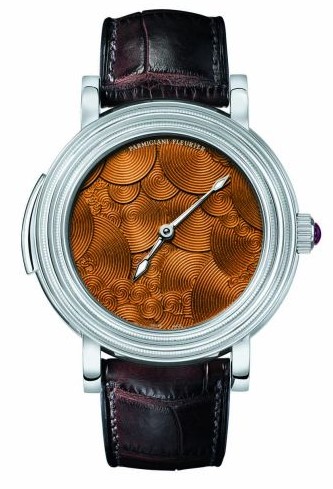A Sound Idea
If you like your watch to sing—from cathedral chime to notes of Beethoven’s Fifth Symphony here is a bouquet of minute repeaters to choose from, writes Hiren Kumar Bose
Particularly demanding to assemble as they require not only supreme watchmaking skills but an artistic talent to tune the sound, minute repeater is a complication that audibly chimes the hours and often minutes at the press of a button. There are many types of repeater, from the simple repeater which merely strikes the number of hours, to the minute repeater which chimes the time down to the minute, using separate tones for hours, quarter hours, and minutes. The repeaters shelter a mechanism that allows the pace of the repeater strikes to be changed. According to John Huguenin’s Etablissage et Repassage des Montres à Répétition “a minute repeater with an average speed takes about twenty seconds to strike 12 hours, three-quarters and fourteen minutes”. A minute repeater can be customised with the prospective buyer asking a watchmaker to change the pace, making it faster or slower. Assembling a minute repeater typically takes 200 to 300 hours, after which the watch must be perfectly tuned to guarantee the superlative standard.
The maiden minute repeaters in their modern form were created by Abraham-Louis Breguet and his team in Paris in the early 19th century, and they invented the circular gong, replacing the tiny bell that had been used in preceding repeater watches. Typically there are two gongs, to differentiate hours, quarters (usually sounded on both gongs) and minutes. A few minute repeaters have four gongs and four hammers so that they can chime the quarters. Probably the most famous melody linked to four-gong chiming timepieces is the so-called Westminster Chimes.
 HUBLOT Classic Fusion Cathedral Tourbillon Minute Repeater
HUBLOT Classic Fusion Cathedral Tourbillon Minute Repeater
The slider that activates the repeater is incorporated in the left-hand resin lug on the side of the case at 9 o’clock, preserving the clean lines of the Classic Fusion case. The sound of the gong is in part transmitted by the case itself. The absence of a dial reveals the movement in all its complication, with the large tourbillon at 6 o’clock, rotating once every 60 seconds, and a total of 319 components. It is manually-wound, with a power reserve of 5 days (120 hours). The large case, 45 mm in diameter, is in King Gold (reference 504.OX.0180.LR) or titanium (reference 504.OX.0180.LR). The gold version is a limited edition of 50, the titanium 90 pieces.
 PIAGET Emperador Coussin Ultra-Thin Minute Repeater
PIAGET Emperador Coussin Ultra-Thin Minute Repeater
The 48 mm pink gold case plays an important part in sound transmission, hollowed as far as possible for good resonance, and connected to the gongs. Piaget commendably provides an indication of volume of the two gongs, 64 decibels, with hours at G# and minutes at A#, and gongs designed to produce extra harmonics for a richer sound. Parts of the movement are visible through the sapphire watchglass, with more, including the hammers and the pink-gold-colour platinum oscillating weight, through the sapphire caseback. There are hour indicators on the dial side, as well as a sunburst guilloché design on the bridges that cleverly marks the minutes. The Calibre 1290P movement required three years work by six engineers, developing it from the Calibre 1200P, the world’s thinnest automatic movement. The cushion-shape of the case itself indicates that this is a special watch, because this format is reserved by the brand for its complication timepieces.
 A.LANGE & SOHNE Zeitwerk Striking Time
A.LANGE & SOHNE Zeitwerk Striking Time
A 44.2 mm striking watch, it has a jumping digital display and a visible chiming mechanism that strikes the hours on a low-pitched tone and the minutes on a higher note. Every quarter-hour, the right-hand hammer strikes once, and on the hour, the left-hand hammer strikes once. So if an hour was compressed into three seconds, the sound would be like the first four notes of Beethoven’s Fifth Symphony. The two stainless steel hammers can be seen towards the base of the dial, on either side of the continuous seconds subdial. The gongs are suspended between dial and bezel. Between the hour and minute digits, a screw on the left of the time bridge is balanced by a sapphire jewel end stone on the right. At the top, the power reserve indicator, particularly important in a manually-wound watch. The pusher at 4 o’clock blocks the hammers to silence the striking function. It is also deactivated when the crown is pulled out to set the time. The watch is powered by the Lange manufacture calibre L043.2 hand-wound, with constant-force escapement and 528 components, superbly finished and visible through the sapphire caseback. The balance runs relatively slowly at 18,000 semi-oscillations per hour; even though the digital jumping display and the striking mechanism absorb a lot of power, the watch has 36 hours power reserve.
Limited to 20 pieces, this 45mm pink gold minute repeater watch has a flying tourbillon with double micro-rotor. The multiple visual and tactile charms of this creation ideally complement the auditory pleasure procured by a beautifully clear, lasting chime. A contemporary expression of the quintessence of traditional horology, the distinctive traits of the Hommage collection are reflected by the sunray guilloché dial and concave bezel, as well as the multi‑layered 3D‑effect self‑winding movement.
 PARMIGIANI FLEURIER Toric Prestige Minute Repeater
PARMIGIANI FLEURIER Toric Prestige Minute Repeater
During this year’s the maison launched not one but three unique piece minute repeaters, namely 46 mm Toric Quaestor “Ripple” manual-wind minute repeater with cathedral chimes with the dial is of solid gold, engraved and hammered by hand to evoke the swirls of a traditional Japanese rock garden, in white gold case; 46mm Toric Quaestor “Grove” manual-wind minute repeater with cathedral chimes with each element of the pine tree motif is applique in gold, on a base of black mother-of-pearl; and the 45mm Toric Kaleidoscope Prestige manual-wind minute repeater with cathedral chimes with the gold guilloche dial featuring a central rosette that rotates when the minute repeater is activated, creating an optical effect like that of a kaleidoscope.
 PATEK PHILIPPE Ladies First Minute Repeater
PATEK PHILIPPE Ladies First Minute Repeater
A watchmaker which considers minute repeater as “pinnacle of horology”, it has an envious collection of 13 minute repeaters, of which 12 are for men. The sound quality of every minute repeater is validated by the President Thierry Stern before it leaves the workshops. The 33.7 mm mechanical self-winding movement watch chimes with two gongs activated by a slide piece in the case. It has seconds subdial, grained cream-coloured dial with gold applied numerals. Interchangeable full back and sapphire-crystal case back. The case is humidity and dust protected only (not water resistant).
 AUDEMARS PIGUET Royal Oak Concept Supersonnerie
AUDEMARS PIGUET Royal Oak Concept Supersonnerie
One of the loudest and clearest minute repeaters to emerge in recent years, the 44 mm Supersonnerie (ref. #26577TI.OO.D002CA.01) seems to be getting better with every edition. The minute repeater on two gongs, tourbillon, chronograph with central sweep-seconds hand, 30-minute counter, hours, minutes is incredibly audible, thanks to two key innovations. Firstly, the silent regulator, essentially a tiny spring that works as an escapement to regulate the speed of the repeater chimes, eliminating the buzz from the traditional governor that interferes with the sound. Secondly, the gongs of the repeater which are attached to a copper alloy disc that acts as a sounding board, amplifying the repeater chimes. Presented in a super-light titanium case, this exclusive timepiece is precision-made to awaken sound. It brings unprecedented acoustic performance, exceptionally refined sound quality and the clear, harmonic tone of traditional pocket-watches to a contemporary minute repeater wristwatch.
The Soprano is a 4-note minute repeater striking Westminster Quarter chimes on four patented cathedral gongs with four hammers–all visible through the front of the watch. This construction avoids any obstacle to effective sound diffusion. Available in Chocolate, Blue and Black, each in 8-piece limited edition the 45mm watch works as a perfect sound box. The gongs of the Soprano are of the cathedral type. These circular rings are wrapped twice around the movement and also feature an invention already patented by the Manufacture, which serves to avoid excessive vibrations and thus any disconcerting buzz when the gongs touch. The dial-free front reveals the striking mechanism, allowing the wearer to marvel at the movement’s architecture —featuring Charles X style skeletonized stepped bridges—the flawlessly finished 60-second tourbillon and the parachute shock absorber. The entirely transparent back of the watch leaves ample room to admire the graceful dance of the springs and gears, accentuated by a ring engraved like a musical stave with a flurry of notes. This wealth of details transforms the most complex horological mechanism into a constantly renewed and melodious symphony
 BULGARI L’Ammiraglio del Tempo
BULGARI L’Ammiraglio del Tempo
The repeater has four gongs and hammers each so that the watch can play a Westminster chime. The watch has a lot of technical innovations, such as a repeater slide that is camouflaged as the bottom left-hand lug, and an unusual detent escapement and constant-force mechanism: rarely used in watches because of the difficulties involved in miniaturising it. It has 516 components, housed in a very large case, 45.75 mm wide and 50 mm high, 14.9 mm thick, reflecting Daniel Roth’s design style (Bulgari purchased Daniel Roth’s brand in 2000). The movement is hand-wound, running at 14,000 vibrations per hour (2 Hertz), with 48 hours power reserve. The deconstructed dial provides views of the chiming mechanism and the detent escapement. The watch is made in two limited editions, 20 pieces in pink gold, and 10 in white gold,
 IWC Portuguese Minute Repeater
IWC Portuguese Minute Repeater
In this 44 mm watch, depressing the repeating slide causes a delicate strike train to sound the time out audibly in hours, quarters and minutes: the full hours on a lower tuned gong, the quarters with double strikes, and the number of minutes that have elapsed since the last quarter on the higher of the two gongs. The repeating mechanism consists of over 200 individual parts working together as if they were in a mechanical orchestra. An all-or-nothing piece ensures that the chimes are only struck if the repeating slide is fully depressed. The watch is equipped with the 98950-calibre hunter pocket watch movement, which comes with stylistic elements from the early F. A. Jones calibres. Both versions are limited to 500 watches.








